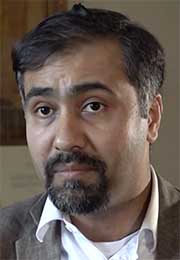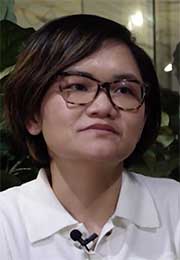Past, Present and Future
For about two decades, China has been funding development projects across the globe. An uptick in spending happened in 2013, with Chinese leader Xi Jinping proposing the creation of what China called the Silk Road Economic Belt and the 21st Century Maritime Silk Road, a land and sea initiative. This concept has evolved over the last 10 years into what is now known as the Belt and Road Initiative (BRI). Observers say China's strategy to globalize may be entering a new phase.
Transcript:
Through its Belt and Road Initiative, China has made its mark worldwide, funding projects as far-flung as power plants in Ecuador and high-speed rail in Laos. But exactly what is the Belt and Road Initiative?
 Ammar Malik
Ammar Malik
Ammar Malik, Chinese Development Finance Expert: “The idea of the Belt and Road Initiative was to develop connectivities between China and the Global South. … The bulk of Belt and Road financing has gone into hard infrastructure sectors such as transportation, energy, mining and projects of that sort. But China has now also folded a lot of their cultural initiatives — their educational initiatives scholarships, Confucius Institute and others — into this big juggernaut of the Belt and Road Initiative.”
Ammar Malik is senior research scientist at AidData, a university research lab at William & Mary that has been collecting information on China’s development finance around the world. The data show that in the past 20 years, the country has emerged as the lender of first resort for many developing countries.
The origins of the Belt and Road Initiative, or BRI, trace back to a time of global economic instability, says Min Ye, an expert in Chinese political economy at Boston University.
 Min Ye
Min Ye
Min Ye, Expert in Chinese Political Economy: “The background story was that (there was the) 2008 global financial crisis, and the world market was shrinking. So, China invested heavily, heavily in building these companies, roads, bridges, factories to produce cement, steel, equipment, power devices — everything. And then the need was (to) reach the top. So, they begin to have, a lot of factories (that) were overproducing so that, the, (in) 2011, (20)12, China’s overcapacity ranging by sectors was about 30 percent to 80 percent. … When Xi Jinping came to power in 2012 [as CCP leader], China actually was in deep, deep overcapacity crisis.”
Then in November 2013, President Xi launched what is now known as the Belt and Road Initiative.
Min Ye: “When the Belt Road was announced, it was just fascinating to see these industrial regulators, businesses, local governments hurrying to seize the opportunity to invest abroad, export abroad, as well.”
Ammar Malik: “Belt and Road is not a single entity. It is not a budget line in the Chinese government’s budget. It is a concept. It is an umbrella under which many entities are delivering projects in many countries across many sectors around the world. … China has built some of the world’s biggest and largest pieces of infrastructure — including bridges tunnels, high speed rail — and they have created a huge ecosystem of state-owned enterprises and financial institutions which have a huge amount of ability to do construction work around the world.”
Min Ye: “It’s more China’s globalization strategy and how to promote, facilitate, Chinese businesses and other organizations (to) go global. Countries, particularly in the Global South, have a real need for infrastructure for goods and for connection with China, so now it’s more like a global initiative rather than just a China initiative.”
Many host countries benefited from Belt and Road projects. In 2016, then-President Rafael Correa of Ecuador celebrated the completion of a Chinese-built power plant.
Rafael Correa, President of Ecuador: “We inaugurated the largest infrastructure ever built in this country, the hydroelectric plant Coca Codo Sinclair. That plant, with a power of 1500 MW, could provide electricity, alone, to all the homes of Ecuador.”
Indonesia is the home of another Chinese project: a high-speed train.
Achmad Rasyad, Indonesia Resident: “It normally takes up to 4 hours, but with high-speed train, I hope it can reduce to 1 to 2 hours.”
But some Belt and Road projects have had a downside. In Ecuador, thousands of cracks appeared in part of the hydroelectric plant, worrying engineers, even though China says the plant, having been tested by third-party agency, is safe.
And as for Indonesia’s high-speed rail …
Meiki Paendong, Indonesian Environmental Advocate: “The construction process uses blasting techniques that damage people’s houses.”
Heru Sutanto, Lives Near Rail Construction: “This is what I’m really worried about. If it shifts, the roof will also fall.”
As with many infrastructure projects, there will be winners and losers, Malik says.
Ammar Malik: “If you are living right next to a highway and you don’t own a car. Or you are a low-income worker and cannot afford to take that expensive high-speed rail, you may have a very different view of the project that was implemented in your neighborhood.”
China observers say that after a decade of implementing Belt and Road projects and fighting the pandemic, Beijing may be recalibrating.
Ammar Malik: “Many experts are calling it BRI 2.0, and it is obvious to us that the era of cheap money with low interest rates and large-scale megaprojects is likely over.”
 Hong Zhang
Hong Zhang
Hong Zhang, China Public Policy Expert: “The pandemic in the past three years really halted a lot of things. … I think the most important reason still was China realized that there’s a lot of challenges or kind of Beijing probably overestimating their ability to implement an agenda which was not very clearly defined in the first place or not very well articulated.”
Ammar Malik: “China is now the world’s largest debt collector, because a lot of these loans that they had given out during the first five years of the Belt and Road area are now only coming due for repayments. And they are realizing a lot of the projects are not as commercially viable as they thought that they might be.”
Min Ye: “China will still do infrastructure, maybe not the kinds of large-scale special economic zones such as the Gwadar Port in Pakistan. They will still do a lot of power plants investments, because Global South needs power. But it will not be coal-powered.”
Hong Zhang, China Public Policy Expert: “The motivation for China to initiate the Belt and Road Initiative was to kind of have to hedge against the potential conflict with the U.S. probably. And so, by doing this or these things, by showing the kind of activism on these fronts through the BRI, that convinced the U.S. and the other powers that China is ambitious. China has these intentions to kind of rewrite or reshape the global order. So, that might end up intensifying the conflicts.”
The Belt and Road Initiative has expanded China’s footprint around the world, and the scope of Beijing’s global influence has changed how the U.S. and its allies see China. Some officials warn China is a threat and is no longer the world’s factory of cheap exports.
Karen Donfried, Assistant Secretary of State for European and Eurasian Affairs: “Europe suddenly realized that China was coming to Europe and buying up strategic critical infrastructure. It changed their perspective on China.”
Min Ye: “I don’t think it’s going to help China become a global hegemon like the U.S. or U.K. in the past. That’s because China’s economy is still hugely internally oriented. … How much China would commit to BRI is decided by how much it helps or works for China.”
Ammar Malik: “Like other large-scale powers, China is keen to increase its global influence, and they would like to develop long-term sustainable engagements with elites in developing countries. They are opening up their universities to foreign students like never before, and they are much more likely to engage in cultural exchanges and to win over public opinion toward China.”
As Beijing paves the path toward an era in which China is one of the largest powers in the world.